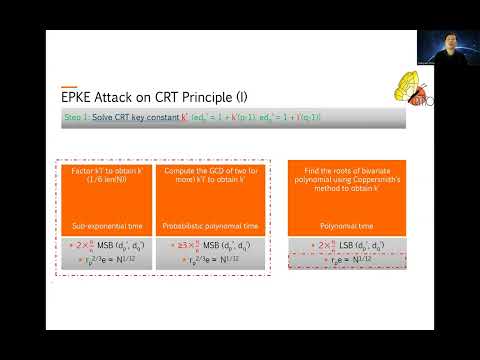CryptoDB
A Third is All You Need: Extended Partial Key Exposure Attack on CRT-RSA with Additive Exponent Blinding
| Authors: |
|
|---|---|
| Download: | |
| Presentation: | Slides |
| Conference: | ASIACRYPT 2022 |
| Abstract: | At Eurocrypt 2022, May et al. proposed a partial key exposure (PKE) attack on CRT-RSA that efficiently factors $N$ knowing only a $\frac{1}{3}$-fraction of either most significant bits (MSBs) or least significant bits (LSBs) of private exponents $d_p$ and $d_q$ for public exponent $e \approx N^{\frac{1}{12}}$. In practice, PKE attacks typically rely on the side-channel leakage of these exponents, while a side-channel resistant implementation of CRT-RSA often uses additively blinded exponents $d^{\prime}_p = d_p + r_p(p-1)$ and $d^{\prime}_q = d_q + r_q(q-1)$ with unknown random blinding factors $r_p$ and $r_q$, which makes PKE attacks more challenging. Motivated by the above, we extend the PKE attack of May et al. to CRT-RSA with additive exponent blinding. While admitting $r_pe\in(0,N^{\frac{1}{4}})$, our extended PKE works ideally when $r_pe \approx N^{\frac{1}{12}}$, in which case the entire private key can be recovered using only $\frac{1}{3}$ known MSBs or LSBs of the blinded CRT exponents $d^{\prime}_p$ and $d^{\prime}_q$. Our extended PKE follows their novel two-step approach to first compute the key-dependent constant $k^{\prime}$ ($ed^{\prime}_p = 1 + k^{\prime}(p-1)$, $ed^{\prime}_q = 1 + l^{\prime}(q-1)$), and then to factor $N$ by computing the root of a univariate polynomial modulo $k^{\prime}p$. We extend their approach as follows. For the MSB case, we propose two options for the first step of the attack, either by obtaining a single estimate $k^{\prime}l^{\prime}$ and calculating $k^{\prime}$ via factoring, or by obtaining multiple estimates $k^{\prime}l^{\prime}_1,\ldots,k^{\prime}l^{\prime}_z$ and calculating $k^{\prime}$ probabilistically via GCD. For the LSB case, we extend their approach by constructing a different univariate polynomial in the second step of the LSB attack. A formal analysis shows that our LSB attack runs in polynomial time under the standard Coppersmith-type assumption, while our MSB attack either runs in sub-exponential time with a reduced input size (the problem is reduced to factor a number of size $e^2r_pr_q\approx N^{\frac{1}{6}}$) or in probabilistic polynomial time under a novel heuristic assumption. Under the settings of the most common key sizes (1024-bit, 2048-bit, and 3072-bit) and blinding factor lengths (32-bit, 64-bit, and 128-bit), our experiments verify the validity of the Coppersmith-type assumption and our own assumption, as well as the feasibility of the factoring step. To the best of our knowledge, this is the first PKE on CRT-RSA with experimentally verified effectiveness against 128-bit unknown exponent blinding factors. We also demonstrate an application of the proposed PKE attack using real partial side-channel key leakage targeting a Montgomery Ladder exponentiation CRT implementation. |
Video from ASIACRYPT 2022
BibTeX
@inproceedings{asiacrypt-2022-32425,
title={A Third is All You Need: Extended Partial Key Exposure Attack on CRT-RSA with Additive Exponent Blinding},
publisher={Springer-Verlag},
author={Yuanyuan Zhou and Joop van de Pol and Yu Yu and François-Xavier Standaert},
year=2022
}

